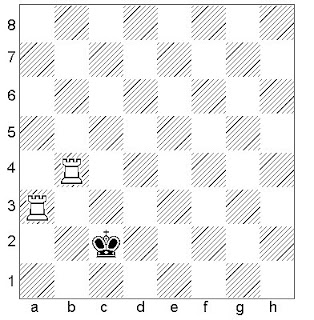
If you have only a king and rook left against your opponent's king, you can still get a checkmate.
The secret is to squeeze your opponent like a python into a corner. The rook forms two "fences" which your opponent's king cannot cross. The idea is to squeeze tighter with the rook whenever you can, but don't check, and don't give away your rook! Keep your king and rook together while you squeeze. If you can't squeeze with the rook, squeeze with the king. If you can't squeeze with either, make a waiting move - just like a python who waits for its victim to exhale, then squeezes tighter. You want to squeeze your opponent's king until he has only two squares. Watch out for stalemate when the king is in the corner. Let's look at all three positions before we look at the final checkmate.
Position 1 (above): Squeeze with the rook if you can. What's the best move?
Answer: Rd4 (Squeezes the enemy king's territory from 12 squares down to only 9 squares.
 Position 2 (left): If you can't squeeze with the rook, squeeze with the king. What's the best move?
Position 2 (left): If you can't squeeze with the rook, squeeze with the king. What's the best move?Answer: Kd4 (Squeezes the enemy king's territory from 12 squares down to only 10 squares. This prepares the way for Rd3 also.)
If you said Kc4, that's a good move too.
Position 3 (left): If you can
 't squeeze with the rook or the king, make a waiting move. What's the best move?
't squeeze with the rook or the king, make a waiting move. What's the best move?Answer: Ke5. Black will have to back up with his king allowing us either to squeeze with our rook or with our king.
When you finally squeeze your opponent down to two squares, you're ready to begin the checkmate. In the diagram below, your rook is in the perfect position - trapping the black king into two squares (a1 and b1). It would be a huge mistake to move your rook to b2! Why? That's right - it's stalemate. (The king has no moves but it is not in check.
 A stalemate results in a draw and each player gets half a point.) Look at the position. There is a long fence (a2 and b2) and a short fence (c1) coming out from the rook trapping the king in the corner. You want your king across the long fence - on b3. So Kb3 is the correct move. Your King is now perfectly placed for checkmate on the "death square". Your two choices for the death square are b3 or c2, but your rook is alread on c2. The death square is the square you want your king to be on to help deliver checkmate. (The death square works in many other endgames as well - KBB vs K, or KBN vs K)
A stalemate results in a draw and each player gets half a point.) Look at the position. There is a long fence (a2 and b2) and a short fence (c1) coming out from the rook trapping the king in the corner. You want your king across the long fence - on b3. So Kb3 is the correct move. Your King is now perfectly placed for checkmate on the "death square". Your two choices for the death square are b3 or c2, but your rook is alread on c2. The death square is the square you want your king to be on to help deliver checkmate. (The death square works in many other endgames as well - KBB vs K, or KBN vs K) Sometimes the position ends up like in the final diagram. This usually fools most beginners.
Sometimes the position ends up like in the final diagram. This usually fools most beginners.But here's a general secret for finding good moves - Think, "Where would my opponent like to move?" Then don't let him move there. This simple rule will help you win many games.
Apply this rule to the diagram on the left. First, your king is now perfectly placed for the checkmate on the death square. So we don't want to move our perfectly placed King. The Black King would like to escape to c1, so don't let him. What's the correct move?
Answer: I hope you said Rc3 or Rc4 or Rc5 or Rc6 or Rc7 or Rc8. That forces Black into the corner where you can checkmate him next turn. How?
Answer: Rc1 checkmate!








